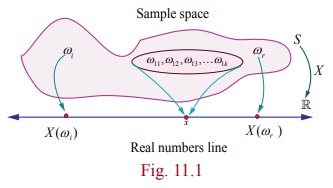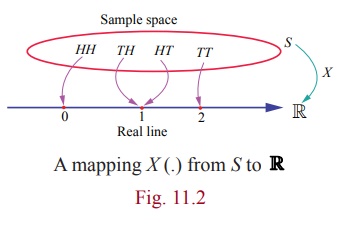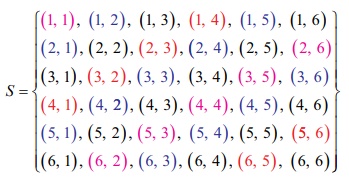Probability Distributions | Mathematics - Random Variable | 12th Maths : UNIT 11 : Probability Distributions
Chapter: 12th Maths : UNIT 11 : Probability Distributions
Random Variable
Random Variable
The
outcome from a random experiment is not always a simple thing to represent in
notion. In many random experiments that we have considered, the sample space S
has been a description of possible outcomes. That is the outcome of an
experiment, or the points in the sample space S , need not be numbers. For
example in the random experiment of tossing a coin, the outcomes are H (head) or T (tail). It is necessary to deal with numerical values, in some
situation, for outcomes of random experiment. Therefore, we assign a number to
each outcome of the experiment say 1to head and 0 to tail. Such an assignment
of numerical values to the elements in S
is called a random variable. A
random
variable is a function.
Thus, a random variable is:
Definition 11.1
A random variable X is a function defined
on a sample space S into the real numbers ℝ such that the inverse
image of points or subset or interval of ℝ is an event in S , for which probability is
assigned.
We use
the capital letters of the alphabet, such as X, Y, and Z
to represent the random variables and the small letters, such as x, y, and z
to represent the possible values of the random variables.
Suppose S = {ω1 , ω2 , ω3
, } is
the sample space of a random experiment and ℝ denotes the real line.
Then the
random variable X
is a real valued function defined on S
and is denoted by X : S → ℝ . If ω
is a sample point in S, then X (ω)
is a real number.

The
range set is the collection of X (ω) such that ω ∈ S .
That is
the range set denoted by Rx
is Rx =
{
X (ω)
/ ω ∈ S}.
Fig 11.1
shows the mapping of some sample points ωi or events of the Sample
space S on thereal line ℝ.
For
instance, if x is a possible value of
X for ω11, ω12, ω13,...ω1k ∈S then {ω11, ω12, ω13,...ω1 k} is called inverse image of x .
That is X −1 (x) = {ω11, ω12, ω13,...ω1 k} is an event in S
Illustration 11.1
Suppose
a coin is tossed once. The sample space consists of two sample points H (head) and T (tail).
That is S T
, H
Let X : S
→
ℝ be the number of heads
Then X (T)
= 0 , and X (H) = 1.
Thus X is a random variable that takes on the
values 0 and 1. If X (ω) denotes the number of heads, then

Example 11.1
Suppose
two coins are tossed once. If X
denotes the number of tails, (i) write down the sample space (ii) find the
inverse image of 1 (iii) the values of the random variable and number of
elements in its inverse images.
Solution
(i) The
sample space S = { H,T } × { H,T }
That is S = {TT, TH, HT, HH}
(ii) Let
X : S → ℝ be
the number of tails
Then
X (TT) = 2 (2 Tails)
X (TH) =
1 (1 Tail)
X (HT) =
1 (1 Tail)
X (HH) =0
(0 Tails)

Then X is a random variable that takes on
the values 0, 1 and 2.
Let X (ω)
denote the number of tails, this gives

The
inverse images of 1 is {TH, HT}. That is X -1 ({1}) = {TH , HT }.
(iii) Number
of elements in inverse images are shown in the table.

Example 11.2
Suppose
a pair of unbiased dice is rolled once. If X
denotes the total score of two dice, write down (i) the sample space (ii) the
values taken by the random variable X,
(iii) the inverse image of 10, and (iv) the number of elements in inverse image
of X.
Solution
The
sample space
S = { 1,2,3,4,5,6
} × { 1,2,3,4,5,6 } ,

consists
of 36 ordered pairs (α, β),where α and
β can take any integer value between 1 and
6 as shown. X is assigned to each point (α, β) the sum of the numbers
on the dice .
That is X (α,β) = α + β.
Therefore
X (1,1) = 1 + 1 = 2
X (1,2) =X (2,1) = 3
X (1,3) =X (2,2) = X (3,1) = 4
X (1,4) =X (2,3) = X (3,2) = X (4,1) = 5
X (1,5) =X (2,4) = X (3,3) = X (4,2) = X (5,1) = 6
X (1,6) =X (2,5) = X (3,4) = X (4,3) = X (5,2) = X (6,1) = 7
X (2,6) =X (3,5) = X (4,4) = X (5,3) = X (6,2) = 8
X (3,6) =X (4,5) = X (5,4) = X (6,3) = 9
X (4,6) =X (5,5) = X (6,4) = 10
X (5,6) = (6,5) = 11
X (6,6) = 12.
(ii) Then
the random variable X takes on the
values 2, 3, 4, 5, 6, 7, 8, 9, 10, 11, 12.
(iii) The
inverse images of 10 is { (4, 6) , (5, 5) , (6, 4)}.
(iv) The
number of inverse images are given below

Example 11.3
An urn
contains 2 white balls and 3 red balls. A sample of 3 balls are chosen at
random from the urn. If X denotes the
number of red balls chosen, find the values taken by the random variable X and its number of inverse images.
Solution
Let us
denote white and red balls as w1
, w2 , r1 , r2 ,and r3
.
The
sample space consists of 5c3
= 10 different samples of size 3.
That is S {w1 w2 r1 , w1 w2 r2 ,
w1 w2 r3 , w1 r1 r2 , w1 r2 r3 ,
w1 r1 r3 , w2 r1 r2 , w2 r2 r3 ,
w2 r1 r3 , r1 r2 r3 } .
The random variable X takes on the values 1, 2, and 3.

Remark
If X denotes the number of white balls,
then X takes on the values 0,1, and 2
and the elements in inverse images are

Illustration 11.2
A batch
of 150 students is taken in 4 buses to an excursion. There are 38 students in
the first bus, 36 in second bus, 32 in the third bus, and the remaining
students in the fourth bus. When the buses arrive at the destination, one of
the 150 students is randomly chosen.
Suppose
that X denotes the number of students
on the bus of that randomly chosen student. Then takes on the values 32, 36,
38, and 44.
Example 11. 4
Two
balls are chosen randomly from an urn containing 6 white and 4 black balls.
Suppose that we win ₹ 30 for each black ball selected and
we lose ₹
20 for each white ball selected. If X
denotes the winning amount, find the values of X and number of points in its inverse images.
Solution
The
possible events of selection are (i) both balls may be black, or (ii) one white
and one black or (iii) both are white. Therefore X is a random variable that take the values,
X (both are black balls)
= ₹ 2(30) = ₹ 60
X (one black and one white ball) = ₹ 30 − ₹20
= ₹10
X (both are white balls) =₹2(−20)= − ₹40
Therefore
X takes on the values 60,10, and − 40.
Note : The inverse image of 40 is { b1b2 , b1b3 ,
b1b4 , b2 b3 ,
b2 b4 ,
b3b4 }.

Illustration 11.3
A coin
is tossed until head occurs.
The
sample space is S ={ H ,TH
,TTH ,TTTH , . . . }.
Suppose X denotes the number of times the coin
is tossed until head occurs.
Then the
random variable X takes on the values
1, 2, 3, . . .
Illustration 11.4
Suppose N is the number of customers in the
queue that arrive at a service desk during a time period, then the sample space
should be the set of non-negative integers. That is S = {0, 1, 2, 3, . . . } and N is a random variable that takes on the values 0, 1, 2, 3, . . .
Illustration 11.5
If an
experiment consists in observing the lifetime of an electrical bulb, then a
sample space would be the life time of electrical bulb. Therefore the sample
space is S [0, ∞) . Suppose X denotes the lifetime of the bulb, then
X is a random variable that takes on
the values in [0, ∞).
Illustration 11.6
Let D be a disk of radius r . Suppose a point is chosen at random
in D . Let X denote the distance of the point from the centre. Then the sample
space S =
D and X is the random variable that takes on any number from 0 to r .
That is X (ω) ∈ [0, r], for ω ∈ S.
Related Topics